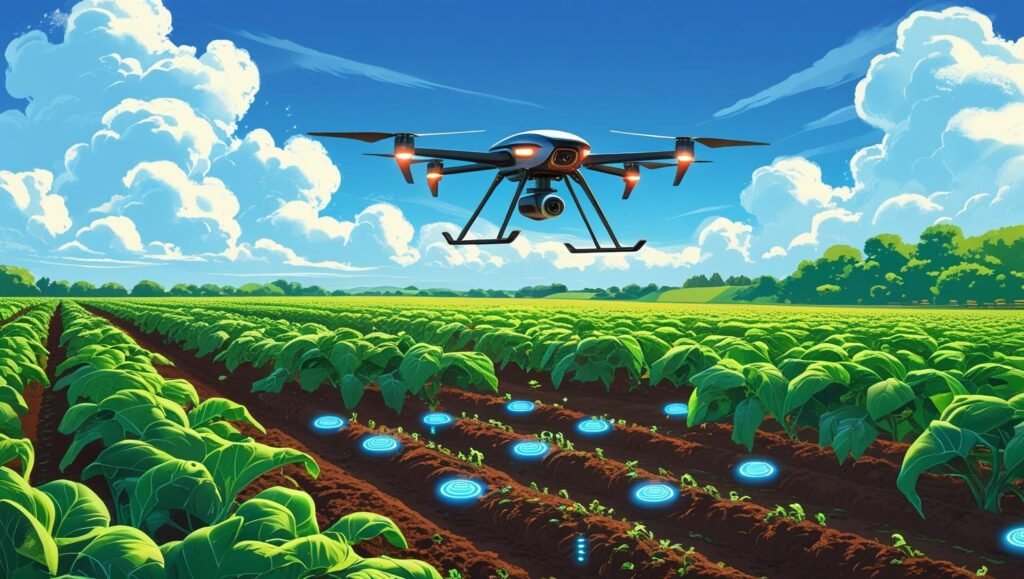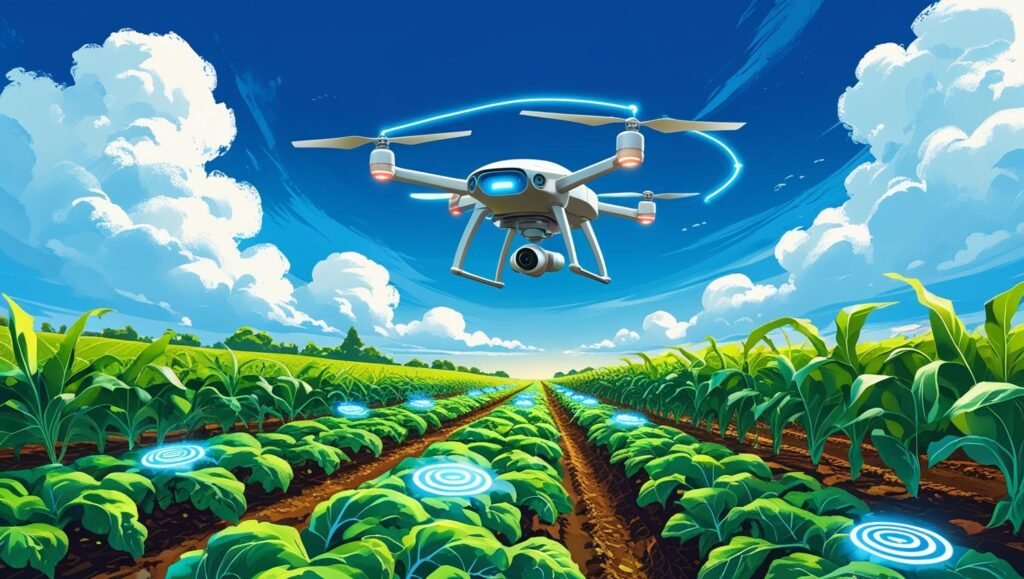IoT in Agriculture Technology: Boost Farming with Sensors

Imagine being a farmer, waking up each day wondering if your crops have enough water or if pests are sneaking into your fields. Farming is tough, and guessing what your plants need can feel like a gamble. That’s where IoT in agriculture technology steps in, making farming smarter and easier with the help of sensors. These tiny devices collect data to help farmers make better decisions, save resources, and grow healthier crops. In this blog, we’ll explore how IoT is changing agriculture, why it matters, and how it can make farming more sustainable and profitable.
What Is IoT in Agriculture Technology?
IoT, or the Internet of Things, is like giving your farm a brain. It uses sensors, devices, and internet connections to gather and share information in real time. In agriculture, IoT means placing sensors in fields, greenhouses, or even on livestock to monitor things like soil moisture, weather, or animal health. This data helps farmers act quickly and wisely, cutting down on waste and boosting crop yields.
IoT in agriculture technology isn’t just fancy gadgets. It’s a practical way to solve everyday farming challenges. For example, instead of watering fields blindly, sensors tell you exactly when and where water is needed. This saves time, money, and precious resources.
Why Farmers Need IoT Technology
Farming has always been unpredictable. Weather changes, pests attack, and soil conditions shift. IoT in agriculture technology helps farmers stay ahead of these problems. Here’s why it’s a game-changer:
- Saves Resources: Sensors track water and fertilizer use, so you only use what’s necessary.
- Boosts Crop Quality: Real-time data helps grow healthier plants with better yields.
- Reduces Labor: Automated systems cut down on manual checks, giving farmers more time.
- Protects the Environment: Precise farming reduces chemical runoff and water waste.
With IoT, farmers don’t just work harder—they work smarter. It’s like having a trusted assistant watching over your farm 24/7.
How Sensors Work in IoT Farming
Sensors are the heart of IoT in agriculture technology. These small devices collect data from the farm and send it to a computer or phone. Here’s how they help:
- Soil Sensors: Measure moisture, nutrients, and pH levels to ensure crops get what they need.
- Weather Sensors: Track temperature, humidity, and rainfall to predict the best planting or harvesting times.
- Crop Health Sensors: Detect pests or diseases early by monitoring plant conditions.
- Livestock Sensors: Monitor animal health, location, and even feeding patterns.
This data flows to a central system, where farmers can see it on a dashboard. It’s like having a live report card for your farm, helping you make decisions fast.
Key Benefits of IoT in Agriculture Technology
Using IoT in agriculture technology brings big wins for farmers. Let’s break down the top benefits:
1. Precision Farming
IoT makes farming precise. Sensors tell you exactly which parts of your field need water or fertilizer. Instead of treating every acre the same, you can focus on specific areas, saving resources and improving crop health.
2. Better Decision-Making
With real-time data, you’re not guessing anymore. IoT in agriculture technology gives you clear insights, like when to irrigate or if a storm is coming. This means fewer mistakes and better results.
3. Cost Savings
Farming can be expensive, but IoT helps cut costs. By using only the water, fertilizer, or pesticides you need, you save money. Plus, automation reduces the need for constant manual checks.
4. Sustainability
IoT in agriculture technology is good for the planet. It reduces water waste, limits chemical use, and helps farmers grow more with less. This means healthier ecosystems and a brighter future for farming.
5. Higher Yields
Healthier crops mean bigger harvests. IoT sensors catch problems early, like low nutrients or pest attacks, so you can fix them before they hurt your yield. More crops mean more profit.
Real-World Examples of IoT in Agriculture
IoT in agriculture technology isn’t just a future dream—it’s happening now. Here are some ways farmers are using it:
- Smart Irrigation: In dry regions, sensors check soil moisture and only water crops when needed, saving up to 30% of water.
- Livestock Monitoring: Ranchers use IoT collars to track cattle health and location, reducing losses and improving care.
- Greenhouse Automation: Sensors control temperature, light, and humidity in greenhouses, creating perfect growing conditions.
- Pest Control: Drones with IoT sensors spot pest infestations early, letting farmers act before crops are damaged.
These examples show how IoT in agriculture technology is making farms more efficient and productive, no matter the size or location.
Challenges of Using IoT in Agriculture
While IoT in agriculture technology is powerful, it’s not perfect. Farmers face some hurdles when adopting it:
- High Initial Costs: Sensors, devices, and software can be expensive to set up.
- Internet Access: Rural areas often lack strong internet connections, which IoT needs to work.
- Learning Curve: Farmers may need training to use IoT systems effectively.
- Data Security: Storing farm data online raises concerns about privacy and hacking.
Despite these challenges, the benefits often outweigh the drawbacks. As technology improves, costs are dropping, and solutions are becoming easier to use.

How to Get Started with IoT in Agriculture
Ready to bring IoT in agriculture technology to your farm? Here’s a simple step-by-step guide:
- Identify Your Needs: Decide what problems you want to solve, like water waste or pest control.
- Choose the Right Sensors: Pick sensors that match your goals, like soil moisture or weather monitors.
- Start Small: Test IoT on a small part of your farm to learn how it works.
- Get Training: Learn how to use the system or hire someone to help set it up.
- Monitor and Adjust: Check the data regularly and tweak your farming practices based on what you learn.
Starting small helps you see results without overwhelming your budget or time.
Comparison of Popular IoT Sensors for Farming
Here’s a quick look at common IoT sensors and what they do:
| Sensor Type | Purpose | Best For |
|---|---|---|
| Soil Moisture | Measures water in soil | Irrigation management |
| Weather Station | Tracks temperature, rain, humidity | Planning planting/harvesting |
| Crop Health | Detects pests, diseases | Protecting crop quality |
| Livestock Tracker | Monitors animal health, location | Ranching and dairy farming |
This table can help you pick the right tools for your farm’s needs.
The Future of IoT in Agriculture Technology
The future of IoT in agriculture technology is exciting. As sensors get cheaper and internet access improves, more farmers will use IoT. New advancements, like AI-powered sensors or drones, will make farming even smarter. For example, AI could predict crop diseases before they spread, or drones could plant seeds with precision. These innovations will make farming more sustainable and feed a growing world.
Small farms will benefit too. Affordable IoT tools are already helping farmers in remote areas grow better crops with less effort. IoT in agriculture technology is leveling the playing field, giving every farmer a chance to succeed.
Conclusion
IoT in agriculture technology is transforming how we farm. With sensors tracking soil, weather, and crops, farmers can make smarter choices, save money, and grow healthier plants. It’s not just about fancy tech—it’s about solving real problems like water waste, pests, and low yields. Whether you’re a small farmer or run a large operation, IoT can help you work smarter, not harder. Start small, pick the right tools, and watch your farm thrive. The future of farming is here, and it’s powered by IoT.
FAQs
What is IoT in agriculture technology?
It’s the use of sensors and internet-connected devices to monitor crops, soil, weather, or livestock, helping farmers make better decisions.
How does IoT save money for farmers?
IoT reduces waste by using only the water, fertilizer, or pesticides needed, and automation cuts down on labor costs.
Can small farms use IoT?
Yes! Affordable sensors and simple systems make IoT accessible for small farms, helping them grow more with less effort.
Is IoT in agriculture safe for data?
While there are security risks, using trusted systems and strong passwords can protect your farm’s data.
Read more: Smart Farming Solutions to Save Water and Money Now




